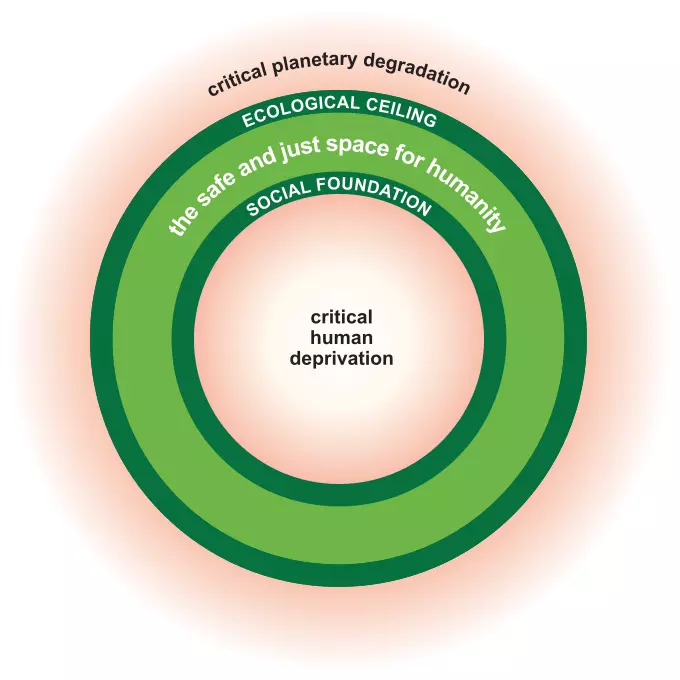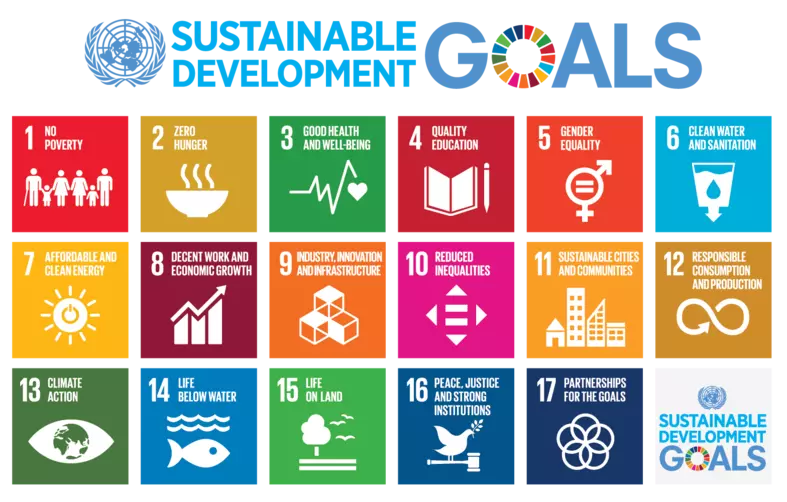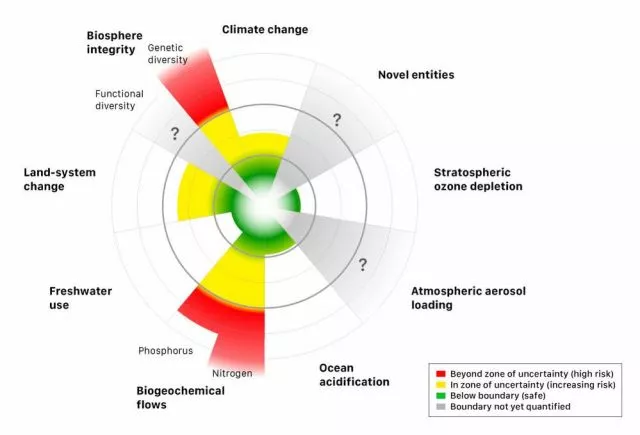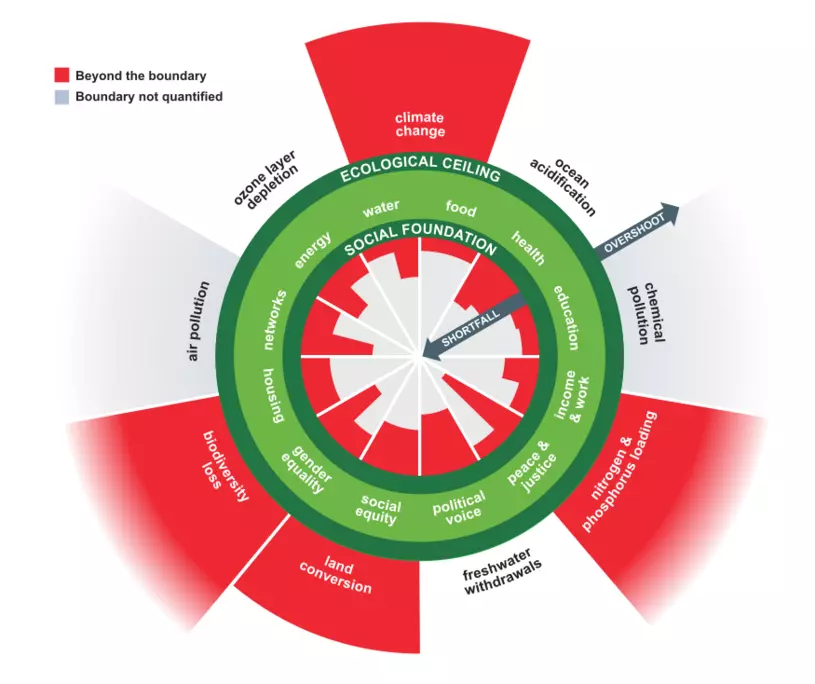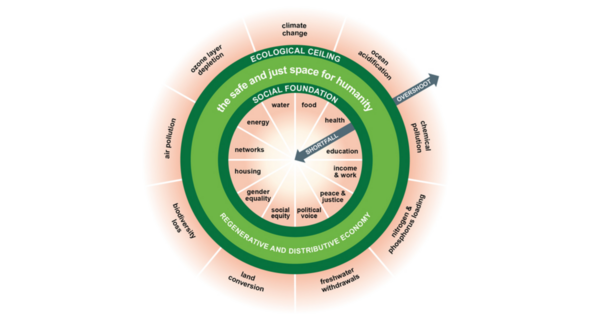
What is the Doughnut?
An introduction to the concept at the heart of Doughnut Economics

Version 1.0 (September 2020)
Overview
This tool is an introduction to the concept at the heart of Doughnut Economics. It's been designed as both a document that can be shared and a presentation that can be given in a classroom, a workshop or a meeting. Either download it as a pdf (below), open it within Google drive (links below) or scroll down to read on this page.
Links
Open as a document in Google Docs
Open as a presentation in Google Slides
What is the Doughnut?
Think of it as a compass for human prosperity in the 21st century, whose goal is to meet the needs of all people within the means of the planet.
It consists of two concentric rings:
- A social foundation – to ensure that no one is left falling short on life’s essentials.
- An ecological ceiling – to ensure that humanity does not collectively overshoot planetary boundaries.
Between these two boundaries lies a doughnut-shaped space that is both ecologically safe and socially just – a space in which humanity can thrive.
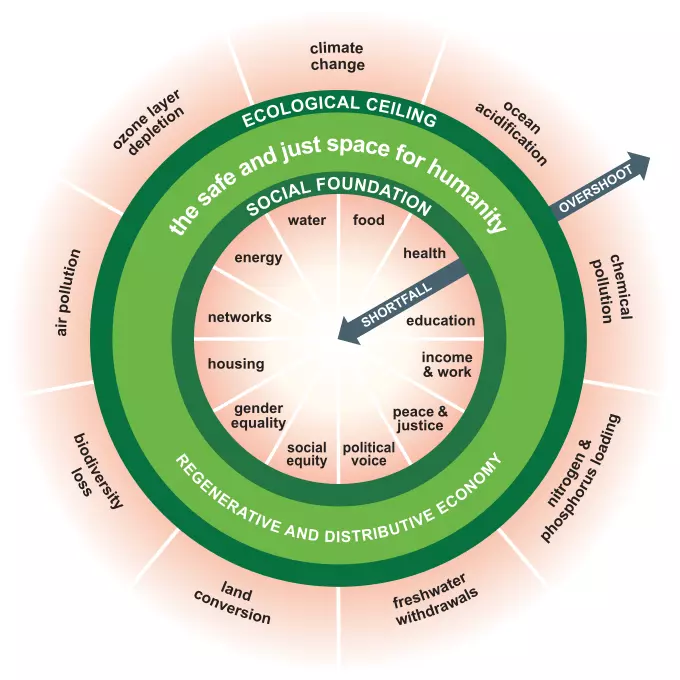
The essence of the Doughnut
1. The social foundation – below which lies critical human deprivation
2. The ecological ceiling – beyond which lies critical planetary degradation
These two boundaries are foundational in the sense that humanity should always seek to avoid critical human deprivation and critical planetary degradation. But how best to define their specific dimensions and measure their current status relative to desired outcomes will keep evolving over time.
The Doughnut’s dimensions
(as of 2017)
The Social Foundation
The 12 dimensions of the social foundation are derived from the social priorities agreed in the Sustainable Development Goals (UN, 2015).
The Ecological Ceiling
The 9 dimensions of the ecological ceiling are the nine planetary boundaries defined by Earth-system scientists (Steffen et al., 2015).
Quantifying the Doughnut
The image below reveals the current state of humanity and our planetary home: think of it as humanity’s ‘selfie’ in the early days of the 21st century.
Each dimension is measured, where possible, with 1 or 2 indicators, and the red wedges show the extent of shortfall and overshoot of the Doughnut’s social and planetary boundaries.
It shows us that millions of people still fall short on all 12 of the social dimensions, and that humanity has already overshot at least four planetary boundaries (air pollution and chemical pollution are currently unquantified).
To achieve the 21st century goal of meeting the needs of all within the means of the living planet means eliminating all of the red from the Doughnut diagram, and this must be done from both sides at the same time.
Find out more
- Explore the dimensions of the social foundation and ecological ceiling
- Explore the selection of these dimensions, including their limitations
- Read chapter one of Doughnut Economics: Seven Ways to Think Like a 21st-Century Economist
Share
Attachments
Share
-
Story

Introducing Doughnut Economics to Izmir, Türkiye
The Izmir Gevrek Model, aiming to live in a thriving, regenerative and inclusive Izmir
-
Story

Innovative Design Framework
At CPI, we are developing a design framework, tailored to meet the complex challenges of the 21st century.
-
Story

2020 Manifesto - A way to a brighter future
How can we all be motivated to make greater connections with ourselves, others, nature and the future?”
-
Story

Mexico City's International Donut Day 2023
About the First International Donut Day in Mexico City, going where the (sustainability) energy is.
-
Story

Bogotá-Building community-Schools and citizens
Last months in Bogotá we have been doing events with citizens and schools to put the doughnut teachings into practice.
-
Story

ChatGPT Meets Doughnut Economics
Designing Doughnut Products and Supply Chains Using Generative AI
-
Story

Embracing the Doughnut as an Early-Stage Start-Up
A personal reflection on my time working with founders launching start-ups with the Doughnut in mind!
-
Story

A regenerative cycling world tour!
Can business save the planet? One man is cycling around the world for three years to find out...
-
Member


Carra Santos
Bath, BANES, UK.
I'm an established and creative sustainability professional, equipping visionary leaders, educators and advisors with knowledge and navigation tools to step into their sustainable futures roles, through education, strategy and communication. Over 20+ years, my career in creativity, design and communication has evolved from internationally-acclaimed product innovation and future concepts for world-class events, to creative thinking skills for visionary leadership. My approach is influenced by my career origins in multidisciplinary concept generation and development - tapping into food, fashion, interiors, furniture, exhibition, spatial and urban design - and my personal passion, which is exploring how transformative habits, attitudes, practices, behaviours and relationships can be facilitated by forward-thinking design and communication. I began exploring Doughnut Economics around 2017, attending events from 2019, and becoming a DEAL community member on its launch in 2020. My interest in economics increased during my 2021 'Sustainable Development in Practice' Masters dissertation on narrative framing and communication of sustainability practices to UK business leaders, which touched on the difference between degrowth, growth-agnostic and growth-led perspectives. I started the Doughnut Economics group in Bath, UK in 2022, and and continue to support it and a number of councils, universities and enterprises with local outreach and engagement. Email me or join me on LinkedIn.
-
Member


Quynh Bui
Paris, Île-de-France, France
-
Member


Thomas Arnold
Bruxelles, Région de Bruxelles-Capitale, Belgium
Active Senior, DG Research and Innovation, European Commission
-
Member


Roman Krznaric
Europe
I am a public philosopher and author of books including The Good Ancestor: How to Think Long Term in a Short-Term World www.romankrznaric.com
